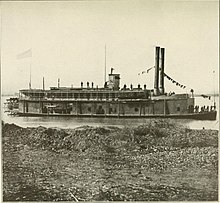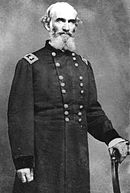Actions near Alexandria
Arkansas The Actions near Alexandria (April 24 – May 13, 1864)[1][2] saw a Confederate States Army force commanded by Major General Richard Taylor surround a greatly superior Union Army led by Major General Nathaniel P. Banks and a United States Navy flotilla commanded by Rear Admiral David Dixon Porter at Alexandria, Louisiana.
Banks' army was compelled to halt its retreat to keep Porter's vessels from being scuttled or from falling into Confederate hands.
Because his administration felt threatened by the French-backed regime of Emperor Maximilian in Mexico, President Abraham Lincoln wanted the United States flag raised over part of Texas.
Major General Henry Halleck ordered Banks, over his objections, to mount an invasion of Texas using the Red River corridor.
Banks was to ascend Bayou Teche with 17,000 troops while Major General Andrew Jackson Smith with 10,000 men (three divisions of XVI Corps and XVII Corps) would move up the Red River accompanied by the 13 ironclads and 7 light-draft gunboats of Porter's river fleet.
Major General Frederick Steele and 15,000 men were ordered to march south from Little Rock, Arkansas, and join the first two columns, but they started too late and never connected with Banks.
Despite low water in the Red River, Banks ordered an advance on Shreveport, Louisiana, and his army occupied Natchitoches on April 2.
At the Battle of Mansfield on April 8, Taylor defeated Banks and forced the Union army back.
Though Taylor's attack was repelled at the Battle of Pleasant Hill on April 9, Banks elected to withdraw to Grand Ecore near Natchitoches.
[4] This decision was influenced by an order to return A. J. Smith's troops to Major General William T. Sherman by April 10.
The rearguard was composed of A. J. Smith's troops who fought off Confederate pursuit and burned any buildings they found along their route.
[8] On April 26, Major General John Alexander McClernand arrived at Alexandria to assume command of the XIII Corps.
McClernand brought the 2,600 troops of Brigadier General Michael Kelly Lawler's brigade and 1,000 replacements destined for the XVI Corps.
According to historian William Riley Brooksher, Taylor sent Brigadier General James Patrick Major with 1,000 soldiers to David's Ferry, downstream from Alexandria.
Brigadier General St. John Richardson Liddell with 700 men covered the east bank of the Red River.
"[16] On April 30, a Union cavalry brigade advancing from Pineville was counterattacked by Liddell's force and defeated with the loss of 30 men at Hudnot's Plantation.
On May 2, a foraging party from the 3rd Rhode Island Cavalry and the 83rd Ohio Infantry suffered 12 casualties near Governor Moore's mansion.
[1] Taylor believed that Banks' troops were demoralized, hungry, and sick, and hoped to achieve a major victory.
When the Union river transport Emma appeared, Colonel Isham Chisum's[19] 2nd Texas Partisan Rangers[20] galloped after it, forced it to surrender, and burned the vessel.
West's battery disabled the John Warner and it drifted into the bank where it endured a terrific blast of rifle fire which caused 125 casualties.
The Covington tried to tow the tinclad away but its own steering was disabled and it drove into the opposite bank where the Confederate guns pounded it.
Colored Infantry[29] presented a plan to build a bracket dam, "to put a foot of water under those boats", and Bailey authorized the work to proceed.
[26] The Confederates blundered in not attempting to interfere with the Federal dam-building, though they were too weak to stop Banks' troops for very long.
When the Federal soldiers began to reload the river transports, they were angry to find the vessels were filled with bales of cotton.
In one case, Confederate soldiers sacked and burned down the plantation of James Madison Wells, whom they regarded as a traitor.
[35] The Confederates of Polignac, Major, and Bagby only skirmished with the Union cavalry, as it led Banks' march.






